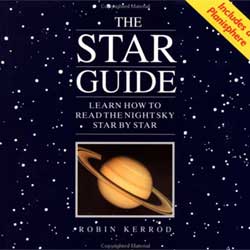
Astronomy is such a wonderful field for the observer. The scene regularly changes and surprises continually pop up. Sharing the wonder with anyone, anywhere else, should be a simple task of saying, ‘Look it’s right there overhead’. However, Kerrod knows better than to drop a coordinate frame into a book and say you’re on your own. First he pummels your senses with eye candy. Plenty of shots from the Hubble space telescope draw you in like a nearby black hole. Chaffing with desire, you continue flipping pages. The Arecibo, Parkes and Kitt Peak sites temp you with dreams of playing with the toys of the big guys. All the while shots of exploding galaxies, planetary nebulae and writhing dark clouds tease you all the more. Once primed with this, Kerrod blasts you along the learning curve for locating the stars.
And learning, with this book as an aid, is as practicable as it is enjoyable. The constellations arrive as the appertif. Their images spread all over maps. Blue circles, with apparently random yellow dots and white lines, place each of the 88 quixotic shapes. Blow-up layouts of the well known ones serve as sign posts to send you on to the next juicy morsel. Having got you salivating, Kerrod brings on the main course. On two page spreads, he dishes out the apparent skies for each month. To ready you for this meal, two half circles give the expected evening view. One portrays the southern exposure from the northern and the other portrays the northern exposure from the south. The ‘entree’ so to speak, maps a 30 degree wide by 100 degree long section of the sky at near reference time of near midnight. With these and additional choice pieces of eye candy , there’s no option but to jump in with utensils ablaze and assimilate all the information.
Just like with any good meal, this book wraps up with a delightfully light selection. Here, to relax the palate, are sunspot examples, the authors own pictures of a solar eclipse as well as maps for the near side of our moon. One simplified sketch for each lunar quadrant identifies all the key features. Then, just as a chef advising on future meals, Kerrod entices you with a final section together with lots more eye candy of the planets of the solar system. Not only do you get well satiated by this meal but there’s always that little bit more to keep you coming back.
Kerrod, with this book, really does a great job in bringing astronomy to the hobbyist. He concentrates on identifying stars and helping you up the learning curve of identification. There is very little on equipment, technique or style. He gives enough information to make the evening viewing fun without overtaxing anyone’s ability to comprehend. The eye candy is there as a practical lure but so is a caveat that reminds the viewer what they will expect to see. With the included planisphere (mine was for latitude 42deg North), learning the main stars and constellations, the learning curve will be more like a gentle slope.
But does it work? I gave it a try by bringing the book with me while visiting a friend at a cottage. Like moths to a lantern, they dived into the book. It didn’t take long for even the most staid to be curious and perusing the contents. Once the planisphere was discovered, we headed down to the shoreline. Sure enough, we identified a number of constellations and had a great time doing so. It does work.
With 88 constellations and an apparently infinite number of bright dots in the night sky, a learner can easily feel overwhelmed. There are many resources, including friends, clubs, web sites and books. Robin Kerrod with his book The Star Guide: Learn How to Read the Night Sky Star by Star adds an excellent reference. With the maps, spectacular photographs and simple yet helpful text, a reader won’t be overwhelmed for long.
Read more reviews, or purchase a copy online from Amazon.com.
Review by Mark Mortimer.
